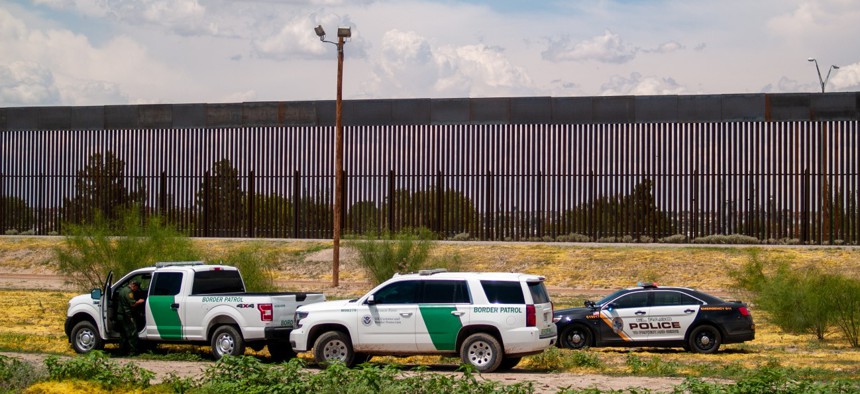DHS' New Limited Policy on Vehicle Chases Brings Hope for Ending Unnecessary Deaths
Nearly 100 individuals have died in car chases with federal border personnel over the last dozen years.
The Biden administration has significantly restricted when many of its law enforcement officers can pursue individuals in vehicles, as it looks to reduce the incidents that have led to dozens of deaths in recent years.
Customs and Border Protection, the nation’s largest law enforcement agency, did not prohibit its officers and agents from engaging in vehicle pursuits when it released a new policy this week, but it did add layers of oversight and create several scenarios in which the practice is banned. The announcement drew plaudits from migrant advocacy groups and derision from the agents on the ground.
CBP personnel must consider the government’s interest before chasing a vehicle, including the severity of the crime committed by those involved. Officers must make a risk-based decision, weighing the threat of the subject and several other factors. They must consider other means to apprehend the subject and if there is a law enforcement need to engage in the pursuit. A pursuit can be triggered when a vehicle fails to stop at a checkpoint or if they fail to yield to an agent attempting to pull it over. Under the new policy, CBP management stressed the act of fleeing itself is not grounds to start a chase.
Agents and officers must weigh whether the erratic driving of the vehicle makes pursuit unsafe, the vehicle is traveling toward dense traffic, a chase would put the public at large at risk, weather and road conditions create too much danger and the chase would take too long. As a general rule, they can only engage in a pursuit when the “governmental interest in apprehending a subject at the moment outweighs the foreseeability of risk to the public, other law enforcement and vehicle occupants.”
According to a tracker maintained by the American Civil Liberties Union of Texas, 93 individuals since 2010 have died while in Border Patrol vehicle pursuits. CBP said it reviewed vehicle pursuit policies at more than two dozen law enforcement agencies across the country to update its own procedures.
“As a professional law enforcement organization, CBP is continually updating policies to reflect best practices, public safety needs, and evolving public expectations,” said CBP acting Commissioner Troy Miller. “The safety of officers, agents, and the public are paramount as we carry out our mission.”
Bernardo Rafael Cruz, an attorney with ACLU of Texas, said vehicle chases to this point have “occurred indiscriminately” and created unnecessary dangers for both those involved and innocent bystanders.
“We welcome a revised CBP vehicle pursuit policy but will continue to review its implementation and seek accountability for any actions by Border Patrol agents that harm our communities,” Cruz said.
The policy will prohibit CBP personnel from boxing in vehicles, engaging in chases with three or more vehicles, entering into Mexico or Canada, pursuing vehicles when they are themselves transporting non-law enforcement individuals, “shadow” chasing from an adjacent lane and passing another law enforcement vehicle without permission. It will also ban them from using “immobilization techniques,” such as ramming their cars into another moving vehicle. The officers and agents must space out at a reasonable distance and activate their body cameras as soon as a pursuit begins. They must quickly notify their command center and immediately end the pursuit if a supervisor acknowledges that notification and does not affirmatively approve of it.
The officers can end a pursuit at any time based on their own discretion, as CBP management will never question that decision. They are required to constantly assess the risks and end their chase whenever it can longer be justified. Supervisors must order the termination of a pursuit if at any point it becomes unnecessary as a law enforcement operation. They must also follow strict procedures for after-action reports whenever a pursuit occurs.
The new policy will take effect in May, which CBP said would give it several months to institute trainings and take other implementation steps. Only employees with the proper training can initiate a pursuit.
The National Border Patrol Council, the union representing Border Patrol agents and a consistent thorn in the side of President Biden and his predecessors, denounced the policy.
“We’re extremely upset,” said Brandon Judd, the union’s president, adding his group was not consulted.
Rebecca Sheff, senior staff attorney with ACLU of New Mexico, said the policy would be welcomed by border communities that have "borne the brunt of CBP's deadly pursuits." Just last week, a CBP car chase ended in two deaths and eight injuries.
“Preserving human life is paramount, and this policy makes that a central consideration by adopting many widely accepted best practices,” Sheff said. We can only wonder how many lives would’ve been saved had CBP implemented these best practices sooner.”








